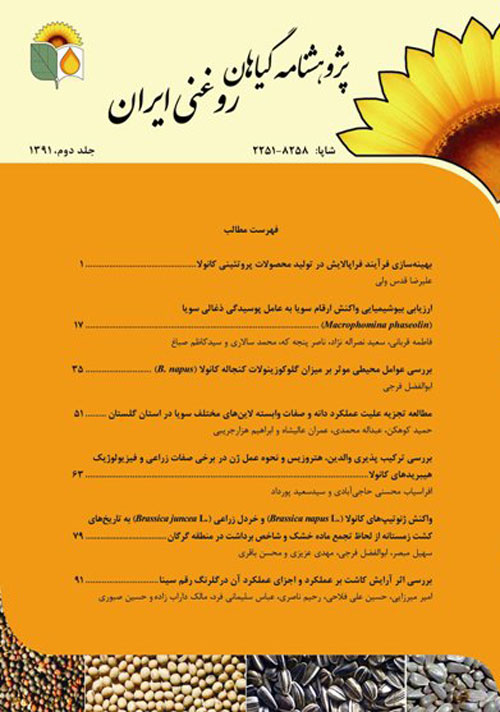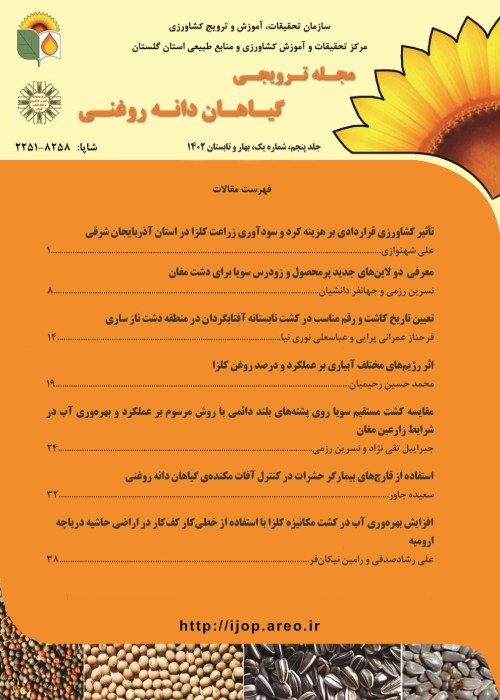فهرست مطالب

نشریه گیاهان دانه روغنی
شماره 2 (1392)
- 108 صفحه،
- تاریخ انتشار: 1392/11/01
- تعداد عناوین: 7
-
Page 1In the present study, the chemical composition (protein, glucosinolate, phytic acid, phenolic acid, crude fiber and ash) of hexane-extracted meals of canola varieties (Brassica napus, cv. Quantum, PF 7045/91, Hyola 401) was investigated and compared with similar to commercial canola meal. The optimum pH for the protein alkaline extraction and isoelectric precipitation of this research samples and commercial canola meal was tested at pH values between 9.5-12.0 and between 3.5-7.5 in increments of 0.5, respectively. The effect of alkaline extraction, isoelectric precipitation, ultrafiltration followed by infiltration and chemical composition as well as protein and solids yield of precipitated and soluble protein isolates were studied. pH had very significant effect (P<0.01) on the nitrogen extractability. The highest protein extractability was observed at pH 12.0 with allmeals investigated. Values of protein extractability were between 37.5% (commercial canola meal) and 60.7 % (PF, hexane-extracted meal). There was highly significant difference (P<0.01) among samples protein precipitation. The optimal pH for protein isoelectric precipitation was determined at pH-values between 4.5 and 6.0. Almost more than 85%) of the proteins were recovered in three usable products: precipitated and soluble protein isolates (PPI and SPI) and a meal residue with about 35% protein, suitable for animal feed. The glucosinolate content of all protein isolates was below the detection limit (< 0.2 mg/g meal). The maximum yield of isolates (PPI and SPI) was obtained from PF variety samples. Precipitated protein isolates had about 85% protein, and there was no significant difference (P<0.01) among them, Although, significant differences (P<0.01) were observed among their phytic acid content. Acid soluble protein isolates showed high purity and protein content (91.0-94.5%), meanwhile, the SPI yield (solids and nitrogen) obtained from commercial canola meal was the least.Keywords: Canola, Alkaline Extraction, Protein Isolate, Ultrafiltration, Diafiltration7
-
Page 17Reaction to the fungal infection is different in various crops. Biochemical Their complex reactions are of the most important defensive mechanisms of the host plants against pathogens. Macrophomina phaseolina is the causal agent of charcoal rot in soybean with high economical damage of plant. In this research, the resistance reaction of five soybean cultivars (Sari, Sahar, Katol, Gorgan3 and Williams) against Macrophomina phaseolina was studied. Additionally, understanding the changes of total phenol and total protein of three cultivars Sari, Gorgan3 and Williams were measured. The measurements were done in 3 different times before, and 48 and 96 hours after inoculation. The experiment was conducted as factorial based on the completely randomized design with four replication in a greenhouse conditions. Results showed a significant difference (P≤0.05) in reactions of cultivars to studied fungus. Based on the Mean value comparison of data, Cultivars were divided into three different groups of susceptibility: Williams's cultivar with %74/99 infections as very susceptible, Sari and Katool with %20/82 and %24/99 of infections, respectively, as moderate resistant group, finally Sahar and Gorgan3 with 41/66 and%45/83 infections, respectively, were grouped as less susceptible. In addition, a significant difference (P≤0.01) was found between total protein and total phenol content of the three varieties in the 48 hours after inoculation. No significant difference was observed in total phenol and total protein of experimental cultivars in different inoculation times. As no significant differences were observed in total phenolic contents (as indicator in plant stress), the moderate resistance reaction especially in Sari cultivar, could be explained due to presence of phytoallexins as important compounds to prevent pathogen damages in host plants.Keywords: Soybean cultivars, Charcoal rot, Resistance, Total protein, Total phenol6
-
Page 35The effect of different environmental factors, such as water used in evapotranspiration and air temperature (AT) during seed filling period, on meal glocosinolate content (MGC) of two canola (Brassica napus) cultivars, was evaluated at Agricultural Research Station of Gonbad, Golestan, in a 2-year study (2005-7). The experiment was a randomized complete block design arranged in a split-plot in two conditions, i.e. supplemental irrigation (SI) and rainfed (RF). Two cultivars of canola (Hyola 401 and RGS003) as subplots were grown at 5 sowing dates (SD) as main plots, with a span of approximately 30 days apart, to obtain different environmental conditions. In both years, SI caused decrease of MGC. The mean MGC in IR and RF conditions was 12.0 and 15.6 μmol/g dry matter (DM) in 2005-6, and 11.7 and 13.2 μmol/g DM in 2006-7, respectively. The negative relationships between MGC with crop water used, and leaf relative water content (LRWC) showed that optimum environmental conditions could have an importantrole in reducing of MGC. MGC was considerably affected by SD, and AT during seed filling period. An increase of 0.087 and 0.11 μmol/g DM of MGC of Hyola 401 hybrid and RGS003 cultivar respectively, for each day delay in SD from November 5, indicating more susceptibility of RGS003 to SD, compared to Hyola 401. Also, with an each degree increase in mean temperature during seed filling stage, MGC increased 1.30 and 1.34 μmol/g DM, for Hyola 401 and RGS003 cultivars, respectively. In overall, MGC was affected by environmental factors during critical period of seed filling. MGC was affected by factors, such as water used in evapotranspiration, LRWC, AT during seed filling period, duration of seed filling period, SD and cultivar.Keywords: Canola, Glocosinolate, Cultivar, Sowing date, Temperature
-
Page 51
In order to study the grain yield and related traits of soybean pure lines in year 2008, 141 pure lines of soybean with three checks (Williams, Sahar and DPX) were evaluated in a simple 12×12 lattice, with two replication at the Agriculture and Natural Resource Research center of Golestan. The analysis of variance results showed that there were significant difference among genotypes for most of the traits which indicates the existence of genetic variations between genotypes. Results showed that grain yield was positively and significantly correlated with traits; days to flowering, plant height, number of branches, number of pods per plant, weight of seed per plant (gram) and percentage of protein. There were also significant and negative correlation between grain yield with oil percent, Step wise regression showed that traits; days to flowering, plant height, number of seeds per pod, number of nod per plant and percentage of protein could justify the highest variations for grain yield. Path analysis showed that the highest and least direct effect on grain yield were number of pods per plant (P=0.29) and percentageof protein (P=-0.26). According to the result number of pods per plant was identified as a selection criteria for improvement grain yield.
Keywords: Soybean, Cultivar, Grain Yield, Path analysis -
Page 63In order to estimate combining ability, heterosis and gene action, 9 rapeseed lines were selected and crossed in 9×9 half diallel method in research field of Dryland Agricultural Research sub-Institute (Kermanshah) in 2008. The parents and their 36 crosses evaluated in an RCBD with 3 replications for 8 agronomic and physiologic traits in 2009. Results showed significant differences among genotypes mean squares of all traits. Specific combining ability variance for all traits except 1000 seeds weight was significant. General combining ability variance for all traits except plant height was significant. The results of genetic variance components and heritability showed that plant height, number of seeds per pod, number of pods per plant, relative water content and seed yield were controlled by dominant genes and had low narrow sense heritability. In contrast, ion leakage was controlled by additive genes and had high narrow sense heritability. 1000 seeds weight was controlled by additive and dominant genes and had moderate narrow sense heritability. Estimation of heterosis in hybrids showed that it was positive and significant in some traits like number of pods per plant and seed yield, in spite of weak and non-significant GCA of parents. It was due to high proportion of dominant variance in heritability of these traits. On the bases of results IL4× IL9 cross due to positive and significant GCA of its parents for seed yield and negative GCA for ion leakage might be used in breeding programs to access high productive rapeseed genotypes. Three hetrotic crosses, i.e. IL1× IL8, IL6× IL9 and IL6× IL7 due to positive and significant SCA for seed yield can be used as thehighestyielding single cross hybrids of rapeseed for introducingto farmers.Keywords: Heterosis, gene action, combining ability, rapeseed3
-
Page 79
In order to evaluate the effect of winter sowing dates on dry matter accumulation and harvest index of canola (B. napus L.) and mustard (B. juncea L.), an experiment was conducted at Agriculture and Natural Resource Research center of Golestan in 2009. The experiment was a spilt plot design, arranged an RCBD with 3 replications. Four sowing dates (January 5, January 20, February 5 and February 20) were main plots and four genotypes Hyola401, RGS003 (canola), and Bard1 and J98 (mustard) were sub plots. Results showed that delay in planting, caused reduction in the shoot dry matter and harvest index in all cultivars under study. The shoot dry matter of mustard genotypes was higher than the canola genotypes in all planting dates. Despite high levels of shoot dry matter of Mustard genotypes, harvest index and grain yield was lower than those of the canola genotypes. The yield of mustard and canola genotypes were 1433 and 2193 kg per hectare and harvest index of them were 14.07 and 23.87 percent, respectively. The lower seed yield and harvest index of mustard might be attributed to lower allocation of dry matter to seeds during filling period. The results of this study showed that under winter sowing dates, mustard genotypes unlike canola genotypes were not suitable for sowing in Gorgan area.
Keywords: Sowing date, White mustard, Canola, Dry matter, Harvest index.2 -
Page 91
In order to study the effects of different planting pattern on yield and yield components of safflower cv. Sina, a field experiment was conducted in summer season of 2008. The experiment was designed as a randomized complete block with a split-plot arrangement and three replications. Main plots were row spacing (30, 40 and 50 cm) and subplots were within row distance (5, 7.5 and 10 cm). Results indicated that the highest and the lowest grain yield was produced at 50 and 30 cm (2848 and 2157 kg.ha-1) row spacing treatments, respectively. With an increase in row spacing, the grain yield increased that might be attributed to higher heads per plant (22.2) and biological yield (5518 kg.ha-1). Within row distance did not have any significant effect on yield and yield components. The highest yield was produced by 50*10 cm planting pattern.
Keywords: plant spacing, yield, yield components, safflower


